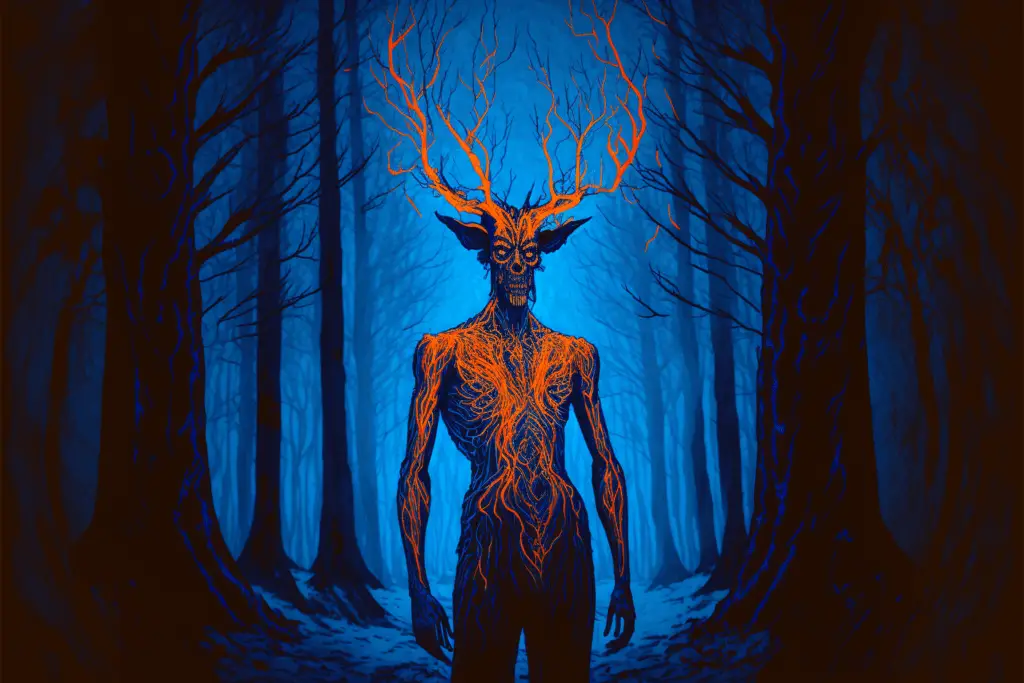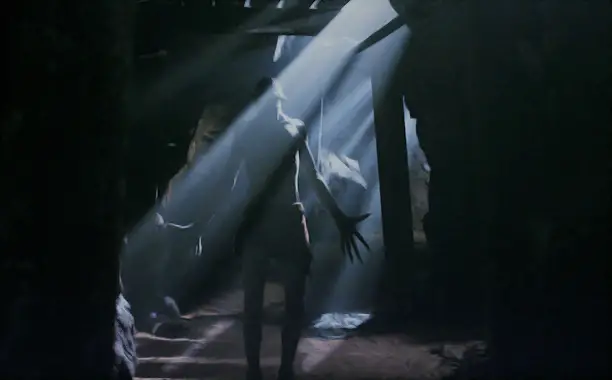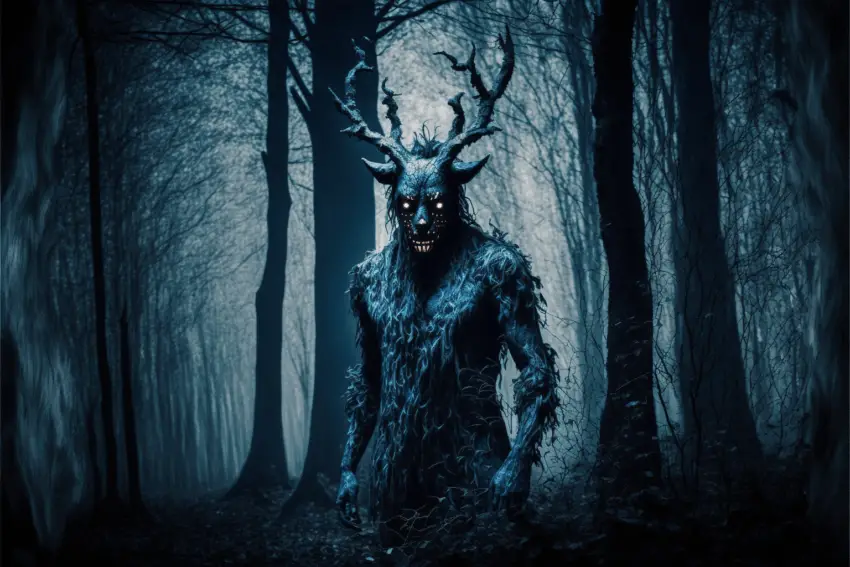Share the Lore!
By: Skylar Black
Does the Wendigo Exist?
If there’s any being that haunts one’s nightmares, it’s the Wendigo. This terrifying spirit, primarily derived from the tales of the Algonquian tribes, is the manifestation of starvation, destruction, and cannibalism, bringing ruin to whoever it touches.
While there are varying descriptions of this creature, its origins, and its behavior, it continues to capture the gruesome imaginations of horror fans and cryptid hunters to this day.
But the question lingers: do these creatures actually exist?

What is a Wendigo?
The creature modern culture knows as the Wendigo is known by several names, depending on which tribe’s lore it’s taken from – Windigo, Witigo, Witiko, and Wee-Tee-Go are all semi-common, and each generally translates to “the evil spirit that devours mankind.”
Their appearance also differs between stories – Algonquian legends describe it as a huge creature formed from ice, cold to its soulless core.
Algonquian Wendigo are skeletal, deformed, and missing lips and toes as though frostbitten.
Ojibwa legend gives the creature a more human appearance, though they remain much taller than a normal human. Their skin is stretched over their bones and ashen pale – their lipless mouths are filled with horrible teeth, and the scent of death and decay surrounds it.
No matter what its outer appearance is, most legends state that a Wendigo is the result of an evil spirit that possesses a human after they resort to cannibalism to survive.
Settlers or hunters trapped in the wilderness in the winter could have been compelled to cannibalize dead comrades for food, but the consequences for these actions were dire.
Other legends extend the possibility for possession to those who are greedy or gluttonous, as the Wendigo are symbols of unending hunger and destruction.
Despite their reputation for being ravenous beasts, Wendigo are by no means, stupid creatures. They are reported to be incredibly intelligent hunters, tracking prey for great distances.
In some legends, the creature can follow a lone human for hours, placing its feet in their tracks so that there’s no evidence of its presence.
Some traditions even state that a Wendigo can mimic human voices, and will call out to prey in the voices of their loved ones to lure them in close.
If you hear a voice in the forest and you know you’re alone, don’t turn around…
History of the Wendigo and Native American Legends
It’s hard to pinpoint the exact origins of the Wendigo mythology because they’re derived from oral traditions, but we do know that they appear in the lore of multiple tribes, including the Algonquian, Ojibwe, Eastern Cree, Saulteaux, Westmain Swampy Cree, Naskapi, and Innu.

There is also evidence of the Wendigo in a Jesuit Relations document from 1661 – the report describes an “ailment unknown to us, but not very unusual among the people we were seeking… [They become] so ravenous for human flesh that they pounce upon women, children, and even upon men, like veritable werewolves, and devour them voraciously, without being able to appease or glut their appetite.”
This is believed to be the first description of a condition known as “Wendigo psychosis”, which is a rare psychological condition that afflicts people who belong to tribes where the legend is present.
The symptoms are things like paranoia, fear of becoming a cannibal, and an intense craving for human flesh.
While the disorder is extremely rare and debated amongst the academic community, there is one prominent case from history that gives people pause: the case of Swift Runner in 1878.
Swift Runner
Ka-Ki-Si-Kutchin, also known as Swift Runner, was a member of the Plains Cree tribe in the Canadian province of Alberta. He was popular amongst his tribe and members of the North West Mounted Police, for whom he acted as a guide on multiple occasions.
By the time he committed his horrifying acts of madness, he was married and a father to six children.
Shortly before the winter of 1878-1879, Swift Runner had become an alcoholic, and his violent binges caused him to be fired by the North West Mounted Police and expelled by his tribe.
As a result, he moved his family, alongside his mother-in-law and brother-in-law, into a remote camp in the wilderness for the winter.
Something happened to Swift Runner over that winter, because when he returned to civilization months later, he was alone. He told the Catholic priests from the mission that he’d stumbled into that his family had starved to death over the winter, but he himself was still over 200 pounds and appeared perfectly healthy.
When he eventually brought them back to the camp, they understood why.
The camp was littered with bones, stripped of meat, and sucked clean of marrow. Many were disturbingly identifiable as human.
A pot full of human fat sat next to the remains of the fire. Swift Runner had killed them all and feasted on their flesh.
He tried to explain that he’d initially only meant to eat his eldest son, whom he’d slaughtered to feed the rest of the group. But when he committed the first heinous act, a wendigo spirit had overtaken him.
Swift Runner was tried and executed for his crimes in late 1879, less than a year after the murders. His tribesmen buried him a great distance from any sort6 of civilization, fearing that the spirit that had possessed him would resurrect him to kill again.
But others weren’t convinced that the wendigo had anything to do with these crimes – after all, Swift Runner had devolved into a violent drunk long before he took his family out into the forest, and many believed that he used the Wendigo legend as an excuse for his terrible deeds.
To this day, no one’s really sure – was he just a terrible man, was he mentally ill, or did he really meet a Wendigo sometime during that long, cold winter?

Jack Fiddler, Windigo Killer
Swift Runner isn’t the only man in history to have expanded his belief in the legend into a terrifying reality.
Jack Fiddler, who was born Zhauwuno-geezhigo-gaubow (he who stands in the southern sky) was a Cree man from the Sucker people of Sandy Lake, which is located on the upper parts of the Severn River in northwestern Ontario, Canada.
He and his brother Joseph Fiddler (born Pesequan) proclaimed themselves as Wendigo hunters and claimed that they were well-equipped to fight off evil spirits.
Jack and Joseph traveled around eastern Canada, seeking out people who were rumored to have committed the taboo of cannibalism, or were summoned at the request of family members who feared one of their own had succumbed to the monster.
Jack Fiddler even killed his own brother, Peter Flett, after the man cannibalized some companions when the food ran out on a trading expedition. By the time he and Joseph were arrested in 1907, Fiddler claimed to have killed 14 “Wendigo”, truly believing that these people were possessed.
Jack committed suicide after his arrest, and Joseph was tried and sentenced to life imprisonment, dying three days before receiving word that he’d been pardoned.
Modern Wendigo Sightings
While stories of humans afflicted with Wendigo psychosis dropped almost to nothing in the 20th century, sightings of the creature are still reported semi-frequently in Canada.
In northern Ontario, there’s a town called Kenora that’s been given the (perhaps unwanted) title of Wendigo Capital of the World – many people in the area have claimed to see a Wendigo lurking around the town for decades, and there are sightings as recent as the 2010s.
There are also some sightings reported across the Canadian prairies and down into Minnesota, though they’re much more common in forested areas.

The Wendigo in Pop Culture
The Wendigo’s terrifying nature and mysterious abilities have made it a perfect boogeyman for modern pop culture. The first mention of the creature in non-Indigenous literature came in 1910 when Algernon Blackwood published his short story “The Wendigo.”
This work would push the Wendigo even further into modern literature – August Derleth, a known contributor to Lovecraft’s Cthulhu mythos, mentioned the creature in two stories: “The Thing That Walked on the Wind” (1933) and “Ithaqua” (1941).
Yet another early story focused on the concept of Wendigo psychosis – Thomas Pynchon’s “Mortality and Mercy in Vienna” describes a character that develops the syndrome and embarks on a killing spree.
Perhaps the most recognizable iteration of the Wendigo in popular literature is the antagonist in Stephen King’s Pet Sematary (1983), bringing the horror of the creature to the forefront of pop culture for over 40 years.
TV has also been fascinated by the Wendigo legend for years – it’s appeared in episodes of Teen Wolf, Supernatural, Blood Ties, Charmed, Grimm, and as a recurring symbol in Hannibal. It even makes an appearance in a Christmas special of the popular Disney children’s show, DuckTales.
As for gaming, Supermassive Games released their decision-based survival horror game Until Dawn in 2015, which uses the wendigo as a main plot point.
The concept appears in Bethesda’s Fallout 76 as well, as a type of mutated enemy who is presumed to have consumed human flesh.
The Wendigo has haunted the forests of North America for centuries and feeds our fears of the dark woods to this day. If trapped in the remote wilderness, do you resort to cannibalism and risk becoming a Wendigo?
Or do you fear there may already be one stalking your every move?
References:
Legends of America: Wendigo - Flesheater of the Forests Dibaajimowin: Zhauwuno-geezhigo-gaubow (Jack Fiddler) The Wendigo Killer Monstrum: Windigo: The Flesh-Eating Monster of Native American Legend Native Languages: Native American Legends: Windigo (Wendigo, Windego) Travels and Explorations of the Jesuit Missionaries in New France, 1610-1791

